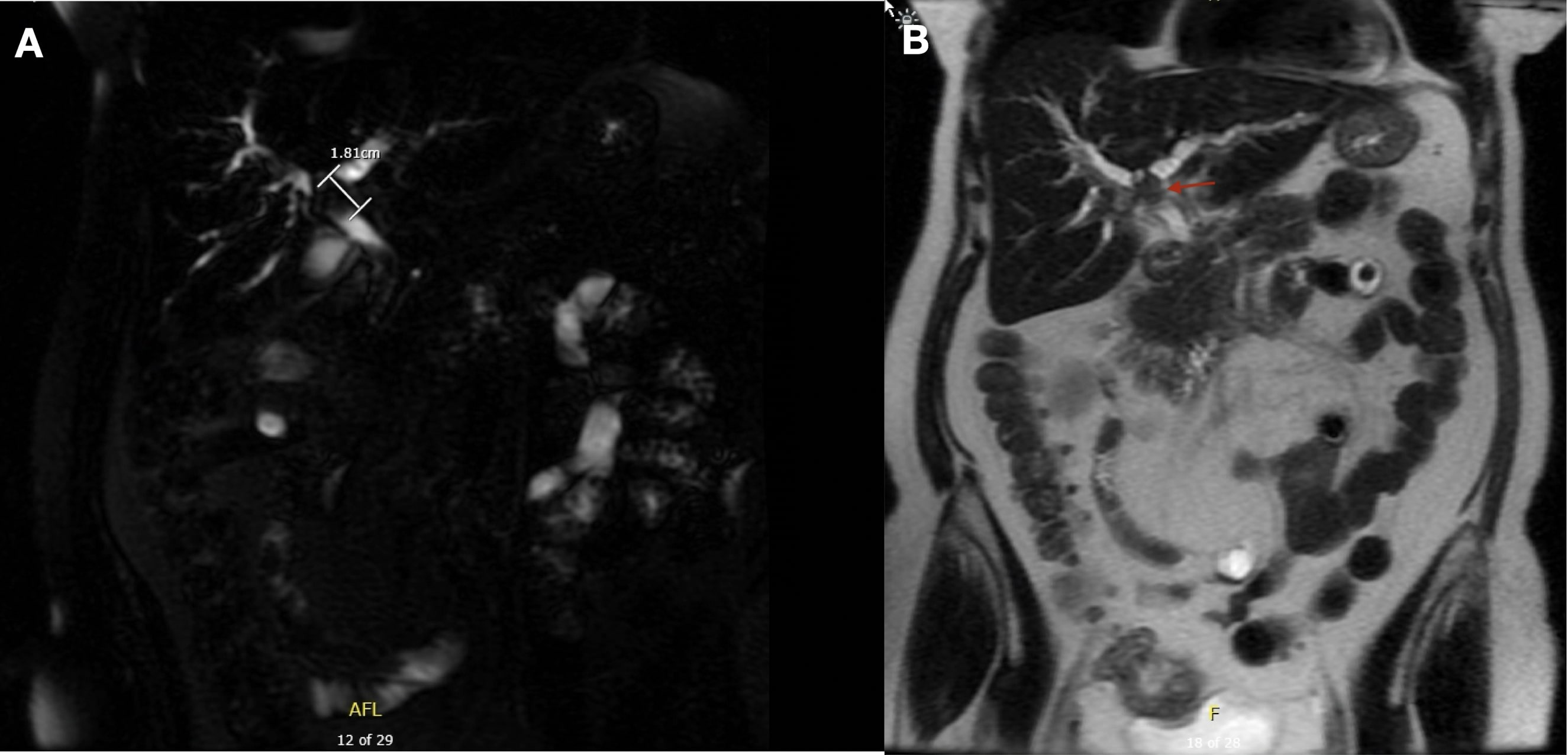Back


Poster Session B - Monday Morning
Category: Biliary/Pancreas
B0060 - A Rare Case of Small Cell Cholangiocarcinoma
Monday, October 24, 2022
10:00 AM – 12:00 PM ET
Location: Crown Ballroom

Has Audio

Arthur A. Cecchini, DO
East Tennessee State University
Johnson City, TN
Presenting Author(s)
Arthur A. Cecchini, DO, Madeeha Sadiq, DO, Steven M. Russo, DO, Puneet Goenka, MD
East Tennessee State University, Johnson City, TN
Introduction: Small cell cholangiocarcinoma is a rare entity and is encountered much less frequently than most other forms of cholangiocarcinoma. This case describes a 63-year-old female who presented with abdominal pain, fatigue, and nausea and was found to have a 1.4 cm mass at the confluence of the left and right intrahepatic bile ducts. This was deemed to be unresectable small cell cholangiocarcinoma, and she was ultimately provided palliative chemotherapy.
Case Description/Methods: A 63-year-old female with a history of chronic obstructive pulmonary disease presented to the hospital with right upper quadrant pain, fatigue, nausea, and bloating. Laboratory studies revealed an alkaline phosphatase (ALP) of 917 U/L, total bilirubin of 3.2 mg/dL, alanine aminotransferase (ALT) of 552 U/L, aspartate aminotransferase (AST) of 285 U/L, and a normal lipase. A magnetic resonance cholangiopancreatography showed a 1.4 cm mass at the confluence of the left and right intrahepatic bile ducts leading to biliary obstruction. Endoscopic retrograde cholangiopancreatography demonstrated a stricture of the common bile duct for which a stent was unable to be deployed. The patient underwent biliary decompression via percutaneous drain placement. A biopsy was obtained during an attempt at surgical resection, but the mass was unable to be removed due to the involvement of the main portal vein. The AFP level returned at 7 ng/mL, CA 19-9 was 6 U/mL, and CEA was 1.6 ng/mL. Biopsies showed positivity for CAM 5.2, keratin AE1/AE3, CD56, synaptophysin, and TTF1. Ki67 index was >95%. Chromogranin was negative. The patient was treated with etoposide, atezolizumab, and carboplatin, however, the disease course was complicated by refractory disease and brain metastasis.
Discussion: Small cell cholangiocarcinoma is a much less prevalent form than other cholangiocarcinomas. Symptoms and signs typically mimic the more common variants of cholangiocarcinoma and often include right upper quadrant discomfort, nausea, dyspepsia, jaundice, fatigue, and weight loss. Laboratory findings include elevations in ALP and bilirubin. ALT and AST may also be elevated, especially when the tumor is intrahepatic. Treatment depends on if the tumor is amenable to surgical resection. If it is unresectable, treatment with cisplatin/etoposide +/- immunotherapy is often used. It is the hope of this case to bring attention to this rare diagnosis and prompt further research into therapies for this malignancy.

Disclosures:
Arthur A. Cecchini, DO, Madeeha Sadiq, DO, Steven M. Russo, DO, Puneet Goenka, MD. B0060 - A Rare Case of Small Cell Cholangiocarcinoma, ACG 2022 Annual Scientific Meeting Abstracts. Charlotte, NC: American College of Gastroenterology.
East Tennessee State University, Johnson City, TN
Introduction: Small cell cholangiocarcinoma is a rare entity and is encountered much less frequently than most other forms of cholangiocarcinoma. This case describes a 63-year-old female who presented with abdominal pain, fatigue, and nausea and was found to have a 1.4 cm mass at the confluence of the left and right intrahepatic bile ducts. This was deemed to be unresectable small cell cholangiocarcinoma, and she was ultimately provided palliative chemotherapy.
Case Description/Methods: A 63-year-old female with a history of chronic obstructive pulmonary disease presented to the hospital with right upper quadrant pain, fatigue, nausea, and bloating. Laboratory studies revealed an alkaline phosphatase (ALP) of 917 U/L, total bilirubin of 3.2 mg/dL, alanine aminotransferase (ALT) of 552 U/L, aspartate aminotransferase (AST) of 285 U/L, and a normal lipase. A magnetic resonance cholangiopancreatography showed a 1.4 cm mass at the confluence of the left and right intrahepatic bile ducts leading to biliary obstruction. Endoscopic retrograde cholangiopancreatography demonstrated a stricture of the common bile duct for which a stent was unable to be deployed. The patient underwent biliary decompression via percutaneous drain placement. A biopsy was obtained during an attempt at surgical resection, but the mass was unable to be removed due to the involvement of the main portal vein. The AFP level returned at 7 ng/mL, CA 19-9 was 6 U/mL, and CEA was 1.6 ng/mL. Biopsies showed positivity for CAM 5.2, keratin AE1/AE3, CD56, synaptophysin, and TTF1. Ki67 index was >95%. Chromogranin was negative. The patient was treated with etoposide, atezolizumab, and carboplatin, however, the disease course was complicated by refractory disease and brain metastasis.
Discussion: Small cell cholangiocarcinoma is a much less prevalent form than other cholangiocarcinomas. Symptoms and signs typically mimic the more common variants of cholangiocarcinoma and often include right upper quadrant discomfort, nausea, dyspepsia, jaundice, fatigue, and weight loss. Laboratory findings include elevations in ALP and bilirubin. ALT and AST may also be elevated, especially when the tumor is intrahepatic. Treatment depends on if the tumor is amenable to surgical resection. If it is unresectable, treatment with cisplatin/etoposide +/- immunotherapy is often used. It is the hope of this case to bring attention to this rare diagnosis and prompt further research into therapies for this malignancy.

Figure: MRCP showing an intrahepatic mass at the confluence of the right and left biliary ducts
Disclosures:
Arthur Cecchini indicated no relevant financial relationships.
Madeeha Sadiq indicated no relevant financial relationships.
Steven Russo indicated no relevant financial relationships.
Puneet Goenka indicated no relevant financial relationships.
Arthur A. Cecchini, DO, Madeeha Sadiq, DO, Steven M. Russo, DO, Puneet Goenka, MD. B0060 - A Rare Case of Small Cell Cholangiocarcinoma, ACG 2022 Annual Scientific Meeting Abstracts. Charlotte, NC: American College of Gastroenterology.
